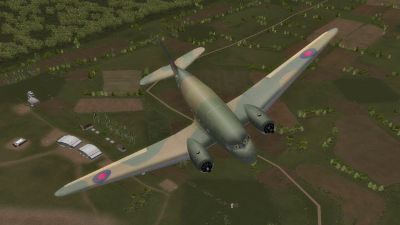Difference between revisions of "Douglas C47"
(Created page with "=Douglas C-47 Skytrain= {| class="wikitable floatright" | colspan="2" style="text-align: center;" | 400px |- style="background:#666600; color:#fff;" |...") |
|||
| Line 39: | Line 39: | ||
Don’t forget to open the door and turn on the jump light (the “O” key) when you are at the drop zone to let the troops know it’s time to hit the silk, this will help them to jump all together and increases their chances of hitting the ground as an effective fighting unit. | Don’t forget to open the door and turn on the jump light (the “O” key) when you are at the drop zone to let the troops know it’s time to hit the silk, this will help them to jump all together and increases their chances of hitting the ground as an effective fighting unit. | ||
[[PARADROP|Paratroop and Infantry transport]] | |||
<hr> | <hr> | ||
Revision as of 18:21, 12 November 2014
Douglas C-47 Skytrain

| |
| Douglas C-47 Skytrain | |
| Specifications | |
| Type | Transport |
| Armament | None |
| Crew | 2 (Pilot, Observer) |
| Weight | 7,700kg |
| Top Speed | 370km/h |
History
The Douglas DC-3 series of transport aircraft is one of the most famous of all time. At one point it became the most common airliner of its day, but its uses as a military supply and transport aircraft, under the designation C-47 Skytrain (or Dakota in British service) are the stuff of legend among those pilots who flew them. It had an enviable reputation as a “piece of cake” to ditch wheels up.
Easy to handle and built to high standards of strength and durability, it was a plane much loved by those who had to fly them, through an extraordinary range of conditions from the safe zones of rear area liaison to the frontlines of mortal combat.
The Gooney Bird as it was very frequently and affectionately known was in fact the most widely used military transport aircraft in the world, and probably in all the history of military aviation. They carried cargo; troops, front line supplies (landed as well as airdropped) and of course was the Allied air armadas basic paratroop transport and drop ship. They could be found in every Allied theater of war, and some axis ones as well. The Russians produced countess examples, and amazingly so did the Japanese, both produced under license arranged before the war, but both versions did include a dorsal turret for some protection.
To this day, the venerable DC-3 / C-47 is still in use, even with the military of some South American countries, some 75 years after it first flew!
Game Play
The whole purpose of this aircraft is getting troops to places you might not be able to by any other means, at least not by means that are fast or expedient. Paratroopers are the obvious choice but any other form or type of infantry can also be transported by C-47 airlift, although you have to land for regular infantry as only paratroops can jump out of the plane…and survive. The C-47 is an easy, somewhat slow but exceedingly simple ship to fly.
When running paratroopers to a drop zone pick routes that are outside of normal air traffic patterns so as to keep your secrecy as long as you can, sometimes flying Nap Of the Earth (as low as possible) can prolong being detected and the C-47 is very good at that flight profile because it handles in such a predictable and steady manner.
You do not have a defensive machine gun which means you must consider either exceptionally good escort pilots with a reputation for keeping their chares alive (a rare thing amongst pilots in Battleground Europe) or you yourself must develop the tactical navigation skills to get your troops to the front in one piece and in a manner where coming under attack from enemy fighters is the exception rather than the rule. The reputation you will make amongst the paratroop brigades of your team will not be a very flattering one if you continually get your boys shot down before they are over the target. The most successful troop transport pilot is able to enter a combat zone without the enemy knowing, drop his troops safely and get back out in a stealthy or surprise manner. And of course not share his airspace with enemy fighters, basically ever.
Don’t forget to open the door and turn on the jump light (the “O” key) when you are at the drop zone to let the troops know it’s time to hit the silk, this will help them to jump all together and increases their chances of hitting the ground as an effective fighting unit.
Paratroop and Infantry transport
| Air Units in Battleground Europe | |
|---|---|
| Fighters and fighter bombers | |
| Bf 109E-1 | Bf 109E-4| Bf 109E-4B |Bf 109F-2 | Bf 109F-4 | Bf 109G-2/R1| Bf 109G-6/U4 | Bf 110C-4 | Bf 110C-4/B | Blenheim IF | Dewoitine D.520 | Fw 190A-3B | Fw 190A-4 | Hawk 75 | Hawk 81 | Hawk 87 | P-40F Kittyhawk Fighter Bomber | | Hurricane Mk I | Hurricane Mk IIb | Hurricane Mk IIc | Hurricane Mk IID | Junkers 87G2 'Stuka' | P-38 'Lightning' | Bell Model 14a / P-400 Airacobra | Model 26 / P-39N Airacobra | Spitfire Mk Ia | Spitfire Mk IIb | Spitfire Mk Vb | Spitfire Mk IXc | |
| Bombers | |
| Blenheim IV | Douglas DB-7 | Havoc Mk.I | A20C Havoc | Heinkel 111 | Junkers Ju 88A4 | Junkers 87 'Stuka' | | |
| Transport | |
| C47 'Skytrain' | Junkers 52 | |